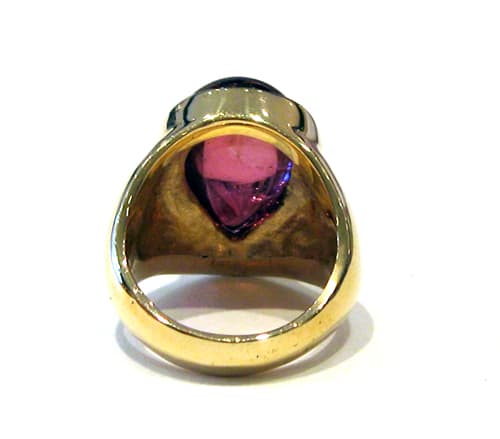18 Karat Gold Ring Set with a Pink Tourmaline
Tourmaline-Gold
FJ.6771
Further images
This Gorgeous Precious Gemstone Has Been Mounted in a Modern 18 Karat Gold Rin Tourmaline's name comes from the Singhalese word 'turmali,' which means 'mixed.' Bright rainbow collections of gemstone...
This Gorgeous Precious Gemstone Has Been Mounted in a Modern 18 Karat Gold Rin
Tourmaline's name comes from the Singhalese word "turmali," which means "mixed." Bright rainbow collections of gemstone varieties were called "turmali" parcels. Tourmaline, occurring in more colors and combinations of colors than any other gemstone variety, lives up to its name. There is a tourmaline that looks like almost any other gemstone. Many stones in the Russian Crown jewels from the 17th Century once thought to be rubies are actually tourmalines.
Perhaps this is why this gemstone is said to encourage artistic intuition: it has many faces and expresses every mood. Tourmaline is also of interest to scientists because it changes its electrical charge when heated. It becomes a polarized crystalline magnet and can attract light objects. This property was noticed long ago before science could explain it: in the Netherlands, tourmalines were called "aschentrekkers" because they attracted ashes and could be used to clean pipes. Tourmaline occurs in every color of the rainbow and combinations of two or three colors.
The soft pink hue of this tourmaline is one of the most popular and highly prized of all colors. In fact, the Empress Dowager Tz'u Hsi, the last Empress of China, loved pink tourmaline so much that she bought almost a ton of it from a mine far away in California and ultimately went to rest eternally on a carved tourmaline pillow. This precious stone has been masterfully cut into a teardrop shape. The reserved gold setting complements the natural hue of the gemstone without attracting attention away from it. Looking at this sparkling gemstone, the unique qualities and stunning beauty of tourmaline becomes evident.
Tourmaline's name comes from the Singhalese word "turmali," which means "mixed." Bright rainbow collections of gemstone varieties were called "turmali" parcels. Tourmaline, occurring in more colors and combinations of colors than any other gemstone variety, lives up to its name. There is a tourmaline that looks like almost any other gemstone. Many stones in the Russian Crown jewels from the 17th Century once thought to be rubies are actually tourmalines.
Perhaps this is why this gemstone is said to encourage artistic intuition: it has many faces and expresses every mood. Tourmaline is also of interest to scientists because it changes its electrical charge when heated. It becomes a polarized crystalline magnet and can attract light objects. This property was noticed long ago before science could explain it: in the Netherlands, tourmalines were called "aschentrekkers" because they attracted ashes and could be used to clean pipes. Tourmaline occurs in every color of the rainbow and combinations of two or three colors.
The soft pink hue of this tourmaline is one of the most popular and highly prized of all colors. In fact, the Empress Dowager Tz'u Hsi, the last Empress of China, loved pink tourmaline so much that she bought almost a ton of it from a mine far away in California and ultimately went to rest eternally on a carved tourmaline pillow. This precious stone has been masterfully cut into a teardrop shape. The reserved gold setting complements the natural hue of the gemstone without attracting attention away from it. Looking at this sparkling gemstone, the unique qualities and stunning beauty of tourmaline becomes evident.





